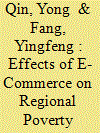| Srl | Item |
| 1 |
ID:
186224


|
|
|
|
|
| Summary/Abstract |
This paper uses the Rural E-Commerce Demonstration County (REDC) policy to estimate the effect of e-commerce on poverty reduction. We discover that the REDC policy enhanced the gross regional product per capita by 8.4 percent for the total sample of counties and 10.5 percent for a subsample of poor counties. Specifically, the REDC policy increased the aggregate final product in primary industry by 10.6 percent. The final product per capita in the secondary and service sectors was 13.1 percent and 3.3 percent higher in the REDCs than in other counties, respectively. The effects were even greater for the subsample of poor counties. The estimates demonstrate that e-commerce developed quickly in the REDCs since the implementation of the REDC policy. The income of those involved in e-commerce increased, yielding more aggregate savings deposits. The expansion of e-commerce induced more investment, suggesting that more aggregate loans are being made in REDCs. This evidence suggests new opportunities for poor people in the new digital economy.
|
|
|
|
|
|
|
|
|
|
|
|
|
|
|
|
| 2 |
ID:
130975


|
|
|
|
|
| Publication |
2014.
|
| Summary/Abstract |
The present paper investigates how neighborhood effects are connected to chronic poverty. We examine a large sample of groups of households and find that neighborhood effects are significant in a majority of groups, especially in the poorest groups. People living in poor communities tend to suffer from poverty over time. It is of theoretical and empirical importance to explore how neighborhood effects are interrelated with chronic poverty and the channels through which this occurs. Unlike other econometric analyses, we establish a multilevel econometric model to show that: (i) it is difficult for an individual living in a neighborhood with a high proportion of agricultural labor, low education levels, and poor transport and telecommunication infrastructure to escape from poverty traps; (ii) neighborhood effects dominate in poor communities; and (iii) although poverty is affected by group-level factors, individual factors still play a dominant role in regards to escaping poverty when income surpasses a threshold level. Therefore, policy priority should be given to providing social protection and public services, especially in poor rural areas
|
|
|
|
|
|
|
|
|
|
|
|
|
|
|
|